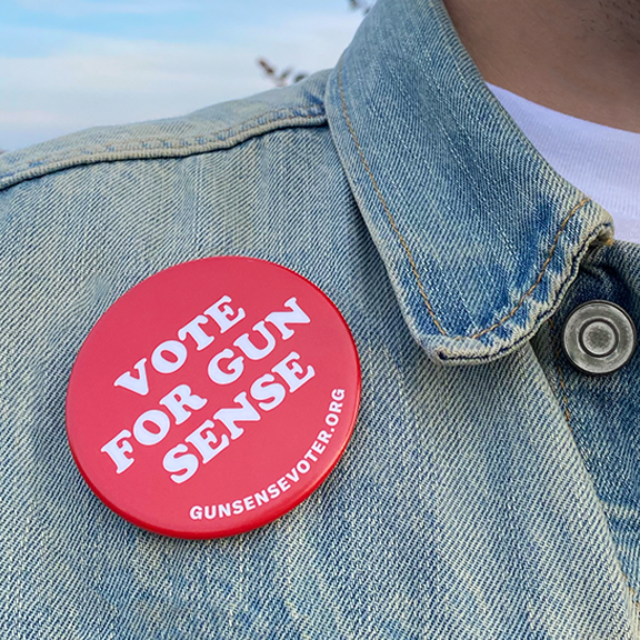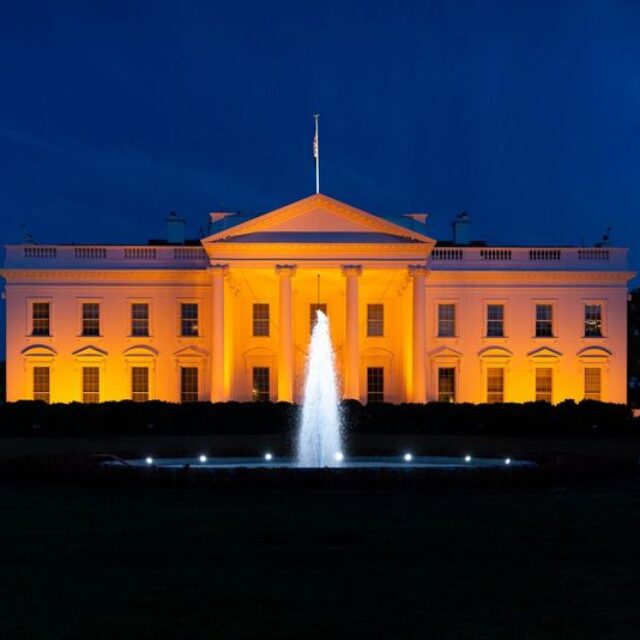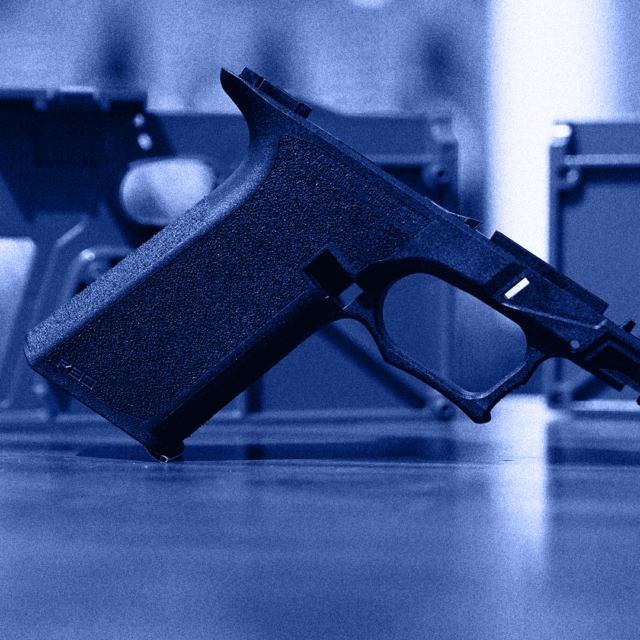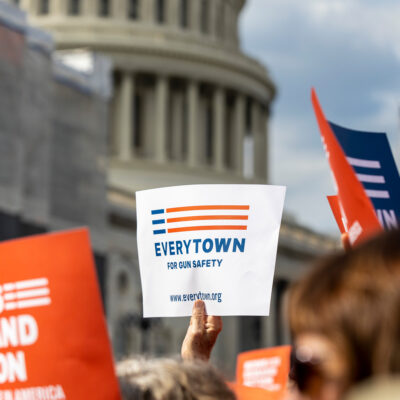
The U.S. Supreme Court will hear oral argument in the Garland v. VanDerStok case on October 8, 2024. Here’s what you need to know.
What’s the question in this case?
The key question in Garland v. VanDerStok is this: Can firearms parts kits be classified as firearms under the Gun Control Act of 1968?
Catch me up: What is the Gun Control Act of 1968?
The Gun Control Act of 1968 defined and regulated firearms.
The Act defined a firearm as “any weapon…which will or is designed to or may readily be converted to expel a projectile by the action of an explosive.”118 U.S.C. § 921(a)(3)(A) The definition also includes “the frame or receiver of any such weapon.”218 U.S.C. § 921(a)(3)(B)
The Act had two main goals:
- To keep guns out of the hands of criminals and others who should not have them.
- To assist law enforcement authorities in investigating serious crimes.
This legislation sought to achieve these goals by regulating those “engaged in the business” of:
- Importing,
- Manufacturing, and/or
- Dealing in firearms.
Under the Act, those who are engaged in the business of firearms:
- Must obtain a federal firearms license,
- Keep records of the acquisition and transfer of firearms, and
- Conduct a background check before transferring a firearm to a non-licensee.
Importers and manufacturers are also required to mark firearms with a serial number.
But in recent years, advances in technology have made it possible for individuals—rather than federally licensed manufacturers—to make unserialized, and thus untraceable, guns at home. These are often referred to as ghost guns.
What are ghost guns?
Understanding ghost guns requires knowing some basic facts about how guns are constructed. Frames and receivers are the core building blocks of firearms. In a pistol, the frame is the bottom half of the gun, housing the trigger and the magazine. The frame also provides a foundation for the slide and barrel (i.e., the parts a bullet passes through when fired). In a semi-automatic rifle, the receiver houses the trigger parts and magazine and attaches to other parts.
In recent years, companies have used advances in technology to manufacture and sell “firearm parts kits” and “easy-to-complete frames or receivers.” These kits made it simple for anyone with basic tools and internet access to make a do-it-yourself, homemade gun from easy-to-obtain building blocks. These kits—often called “ghost guns”—were previously available for purchase with no background check and no questions asked.
A ghost gun has three key, related characteristics:
- It is unserialized;
- It is untraceable; and
- Its building blocks are acquired without a background check.
Most ghost guns are made from “unfinished” frames and receivers. Unfinished frames and receivers are often marketed as “80 percent” complete. That number suggests a buyer needs to do only 20 percent of the work for the frame or receiver to be assembled into an operable firearm. In reality, these parts can be finished in an hour or so or less.
For years, ghost guns represented the fastest-growing gun safety threat to our communities. Felons, minors, and others who are prohibited from buying firearms were able to acquire ghost guns by simply ordering them over the internet and having them delivered to their doorsteps. They can do so without a background check or verifying their identity, circumventing existing laws.
Ghost guns do not have records or serial numbers. This lack of identification has “severely undermine[d]” law enforcement’s ability to trace guns used in crimes back to their last point of sale to determine their owners. Ghost guns, with their lack of serial numbers, impair “law enforcement’s ability to apprehend violent individuals who may pose an ongoing threat to public safety.” According to the Bureau of Alcohol, Tobacco, Firearms and Explosives (ATF), law enforcement agencies recovered 1,758 ghost guns to the ATF for tracing in 2016. In 2021, the number recovered was 19,344—an over 1,000-percent increase.
What led to this case in the first place?
In 2022, the ATF sought to address the threat ghost guns pose to our communities and to law enforcement. It issued a rule clarifying that certain products can be classified as firearms as defined in the Gun Control Act of 1968. This new rule clarified that weapons parts that may be readily converted into an operational firearm or a functional frame or receiver of a firearm—including ghost gun kits—fall within that definition.
“A matter of ordinary usage”
“If a State placed a tax on the sale of tables, chairs, couches, and bookshelves, IKEA could not avoid paying by insisting that it does not sell any of those items and instead sells ‘furniture parts kits’ that must be assembled by the purchaser. So too with guns: A company in the business of selling kits that can be assembled into working firearms in minutes—and that are designed, marketed, and used for that express purpose—is in the business of selling firearms.”
—Solicitor General Elizabeth B. Preloger, et al., Brief for the Petitioners
One of the animating factors of the Gun Control Act of 1968 was the many assassinations that had occurred in the years prior. One of these was President John F. Kennedy’s assassination, which was carried out with a mail-order rifle.
Today, ghost guns are the modern-day equivalent of a mail-order gun. You can’t buy a gun in the mail any longer. But until the 2022 ATF rule was put in place, you could go on the internet and, with just a few clicks of the mouse, have a gun-building kit delivered to your door—no questions asked.
The 2022 ATF rule closed a giant loophole that undermined exactly what Congress was trying to do with the Gun Control Act.
As the Department of Justice stated, the ATF’s new rule “makes clear that parts kits that are readily convertible to functional weapons, or functional ‘frames’ or ‘receivers’ of weapons, are subject to the same regulations as traditional firearms.”
These regulations for manufacturers and sellers include:
- Obtaining licenses;
- Marking products with serial numbers;
- Conducting background checks; and
- Keeping transfer records.
As the petitioner’s brief states, these regulations “on the commercial sale of arms” are the same regulations “that around 80,000 manufacturers and distributors of firearms comply with in millions of transactions each year.”
Since the rule’s enactment, gun groups, certain state attorneys general, and ghost gun sellers, including Polymer80, have sued the ATF and the Department of Justice in an attempt to stop the rule from being implemented. Their complaints allege that the ATF—tasked with enforcing gun serialization and sales requirements that have been on the books since the Gun Control Act was enacted in 1968—does not have the authority to promulgate the rule.
The U.S. Department of Justice asked the Supreme Court to confirm that the ATF’s ghost gun rule is lawful and enforceable. The Supreme Court accepted the case.
Why did this case go to the Supreme Court?
In 2023, the ghost gun industry challenged two provisions of the 2022 ATF rule in a district court:
- That certain weapon parts kits fall within the Act’s definition of “firearm”
- That the statutory term “frame or receiver” includes partially complete frames or receivers (i.e., ghost guns).
A federal district court—and later the Fifth Circuit Court of Appeals—overturned the new ATF rule when it was challenged in court. The Fifth Circuit held that the ATF rule “flout[ed] clear statutory text and exceed[ed] the legislatively-imposed limits on agency authority.”
Now, the Supreme Court will rule on whether the ATF had the authority to regulate ghost guns and other weapons parts kits as firearms under the Gun Control Act of 1968.
What’s at stake in this case?
Ghost guns pose a significant threat to our communities and law enforcement. Before the 2022 ATF rule, felons, minors, and other people prohibited from buying firearms could acquire ghost guns without a background check or verifying their identity, circumventing existing laws.
How many ghost guns are used in crimes?
A recent report released by the Everytown for Gun Safety Support Fund analyzed recovered crime gun data from cities across the country. The data received included 178,218 crime guns recovered in 34 U.S. cities over the past five years. Of that number, nearly 70,700 suspected ghost guns were recovered at crime scenes.
The report found that recoveries of Polymer80s—the leading manufacturer of ghost gun parts and kits—increased nearly 1,200 percent over the past five years. Following the implementation of the ATF ghost gun rule and a recent wave of ghost gun legislation, Polymer80 ghost gun recoveries declined by 28 percent—the first drop in recovery numbers since 2019.
Polymer80 Ghost Guns Recovered by Law Enforcement in 28 Cities
The Fifth Circuit’s ruling would reverse this progress and “make it trivially easy to circumvent the central requirements of the federal firearms law.”
As the VanDerStok case moved through the lower courts, the Supreme Court twice granted the ATF emergency relief. Its intervention allowed the ATF to continue subjecting ghost guns to the same regulations as other firearms under the Gun Control Act of 1968.
On October 8, 2024, the Supreme Court will hear oral argument in Garland v. VanDerStok. How the Supreme Court decides this case will determine whether kits for assembling ghost guns will be regulated like the deadly firearms they are. Everytown, alongside other gun violence prevention groups, urges the Supreme Court to reverse the Fifth Circuit’s reckless decision and uphold the ATF’s commonsense rule.
Join the Courts Advocacy Team
Be the first to know when the Supreme Court rules on this case, and learn how we’re fighting back against the gun lobby. Click here to join the Everytown Courts Advocacy Team to stay updated on major decisions that impact gun safety laws.
The Latest

Voter Guide: What To Know Before Election Day

What the White House Office of Gun Violence Prevention Has Accomplished In Its First Year

What Is a Weekend of Action?





